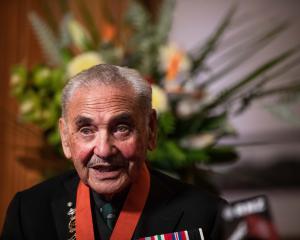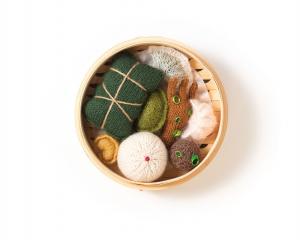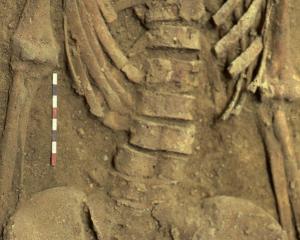After nearly 50 years making jewellery Tony Williams is looking forward to semiretirement. Rebecca Fox discovers the rich history of the craftsman.
Dunedin goldsmith Tony Williams has a passion for precious materials, and a fondness for Art Nouveau and objets d'art.
''I think precious materials are precious for a jolly good reason: they're fabulous,'' he says. ''Why wouldn't you use them.''
Mr Williams is celebrating 40 years in business this month, his approach to his art exemplified in his fondness for a white enamel rabbit inspired by Alice in Wonderland.
''I'm very fond of my rabbit,'' he says. ''He went off to Australia in a heart-shaped box.''
Mr Williams was so sad at its departure he contemplated making a matching rabbit.
''But I decided it wouldn't be the same.''
The rabbit was part of a series of work Mr Williams did for the Australian market in the 1980s and 1990s that often featured enamel, diamonds, pearls, 18-carat gold and moving arms and legs.
His passion for precious metals and what could be fashioned from them, took a while to develop, despite a family craftsman background - his grandfather was a notable wood carver.
He left school with no idea of what he wanted to do so went to university, as was expected by his family.
''I proceeded to drop out. It wasn't me, I'm not an academic.''
Then he tried art school. It was a better fit but still not right and he again dropped out.
A chance viewing of Kobi Bosshard's contemporary jewellery ignited his interest and with help from another artist he learned to make copper jewellery, which was very fashionable in the 1960s.
''There were craft shops everywhere. I'd take a bag of rings and dump them down on a counter at some jewellery shop.
''I'd try to make a ring an hour. I've never been as fast since.''
Soon he felt the need to learn how to make jewellery properly and through his father's connections secured an interview at the Birmingham School of Jewellery.
''It was fabulous. I found my niche.''
He became so obsessive about making jewellery he was not aware of what was going on around him.
''I had tunnel vision. I was there to make jewellery and I did it every moment I had.''
After finishing his studies, he continued his ''training'' working for jewellers in Birmingham and London, including the late Andrew Grima, one of the ''leading lights'' of contemporary high-end jewellery in Britain in the 1960s and 1970s.
''He was doing very experimental and radical stuff. Nowadays the radical stuff tends to be done at the bottom end of the market.''
He came back to New Zealand in 1975 and ended up in Dunedin thanks to the offer of a cottage for $8 a week.
''We had no money back then and even in those days $8 was pretty good rent.''
A jewellery workshop was set up in the cottage and another a few years later in the house they bought in St Leonards.
In 1989, Mr Williams took a sabbatical and returned to England with the aim of learning more about the skill of enamelling.
''Again I fluked the job with a mix of gall and luck.''
As he ended up filling in for a trained enameller, he learned the skills quickly while working on multimillion-pound objets d'art.
''I worked on some extraordinary stuff. This was Fabergé territory almost literally. We made an 18-carat gold tortoise, 90cm across, which could walk.
''It was absolutely mind-boggling stuff. There was millions of pounds going through that workshop and there I was painting by numbers.''
He came back to New Zealand with a newfound confidence and began to push into the export market. An earlier foray in the high-end London jeweller Asprey ''fell flat on its face''.
Australia was the next stop and he managed to get a toehold in that market eventually, working for one retailer.
''We did some extraordinary pieces for them. Pearls made into birds with enamel wings and diamond eyes.''
With that work, his workshop had grown to accommodate three jewellers as well as a secretary.
''It's like catching a wave that we rode until they changed direction.''
It was when the workshop outgrew its suburban location that Mr Williams moved into Dunedin city, setting up in Moray Pl.
However, when the Australian work began to wane and rents began to increase he moved into the workshop and gallery space he now occupies in the Carnegie Centre.
''I've gone from supplying New Zealand, to England, to Australia and now to mainly Dunedin and once again working by myself.''
His jewellery is influenced by his fondness for Art Nouveau and Renaissance jewellery but at the end of the day it is the balance of ideas, materials and craftmanship that makes a piece, he says.
He puts his longevity in the jewellery business down to valuing his work and skills appropriately, and enjoying and investing in the business side.
''Kobi Bosshard has said we didn't know how lucky we were in the '70s and '80s when there was a strong market and the things we made sold. You could put your energy and effort into making and the selling took care of itself. That is gone. Now far too much effort goes into selling.''
Chainstore retailing has also made things difficult for craftsmen as the retail outlets from which their work sells struggle to survive without being able to sell their ''bread and butter'' products.
Mr Williams plans to close his gallery in the next year and return to working from home, producing special pieces, and is also re-establishing links with galleries and outlets around the country.
''I hope to be one of those people who are busier in retirement than they were before.''












